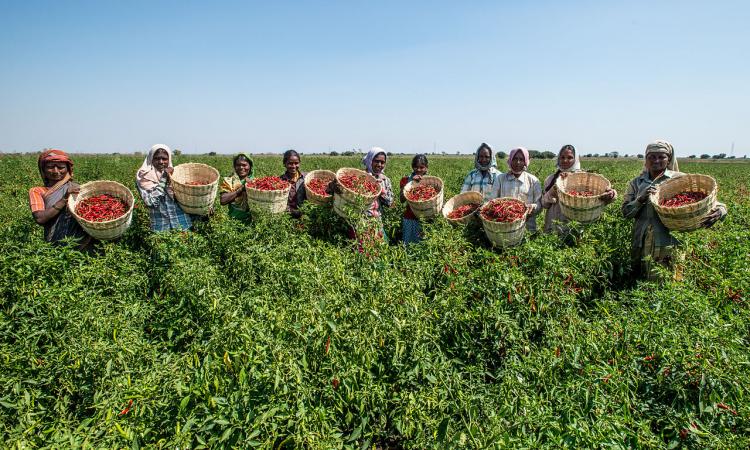
It is now widely recognised among policymakers and practitioners that women’s ownership of agricultural land is an important determinant of their economic and social status, physical security, and the wellbeing of their family informs this paper titled 'How many and which women own land in India? Inter-gender and intra-gender gaps' published in The Journal of Development Studies. Equal land rights for women is also a key target of Goal 5 on gender equality in the United Nation’s Sustainable Development Goals (SDGs).
Very little information exists on land ownership among women
However, many countries such as India lack comprehensive country-wide estimates of the gender inequality in land ownership. Most studies focus on indicators such as percentage of women owning land or what percentage of landowners are female. However, there is a lack of studies that look at different aspects of inequality such as details of individual vs. joint ownership, and the proportion, area and quality of land owned.
Although women can acquire land by various means, such as inheritance, gift, purchase, or government transfers, inheritance is usually the most important mode in in South Asia via which women acquire agricultural land which is largely owned privately, as women are more financially constrained than men in their ability to purchase any.
All the post-Independence reforms have focused on strengthening women’s rights as daughters rather than their rights as widows or wives and on encouraging women to acquire land as daughters, especially as coparceners in joint family property. However very little information is available on whether this exists in reality.
This paper discusses the findings of a study that assesses the parameters of rural women’s land ownership across nine states, and changes in the same set of households over a five-year period, 2010–2014, for all the surveyed states, and over 2009–2014 for five states.
The study finds that:
- Barely 14 percent of women are landowners owning 11 percent of agricultural land in rural landowning households, averaged across states.
- In 2014, women owned land in only 16 percent of the households across regions (8 percent of these households also had male owners, while 84 percent had no female owners at all).
- The highest percentage of households with female landowners is in Telangana (44 percent) and the lowest was in Odisha (6 percent) while that for men were 82 percent and 98 percent respectively. Thus, nine years after the enactment of the HSAA 2005, and over time (2010–2014), there has only been a slight upward trend in several states, but the change is small, and some states, such as Maharashtra, Madhya Pradesh and Gujarat remain nearly flat or even show a slight decline.
- Female landowners form only 14 percent of all landowners with the south doing better than the rest of India. In 2014, 23 percent of all landowners in south India were women as compared to 10 percent in west and central India and 11 percent in east India.
- Telangana is an outlier even among southern states and this could be attributed to the long history of government and NGO efforts to help women acquire land in the undivided state.
- As high as 87.5 percent of the plots across all nine states are owned by individual men, 10.2 percent by individual women, and only 2.3 percent jointly by one or both. There are no jointly owned plots in eastern states or in Madhya Pradesh (central India). The low levels of joint ownership can be because rather little land is being held as coparcenary property, and (for women) because the HSAA 2005, whose primary contribution was to recognise the rights of all daughters in joint family property, especially agricultural land, has had little impact on this count. In terms of households too, only 10 percent of the 1114 landed households contain both individual and joint plot owners.
- Aggregated across states, women own only 11 percent of agricultural land. State-wise, the western, central and eastern states show women owning less than 13 percent of the farm land, and even in south India, in the best performing state, Telangana, the gap is high, with women owning only 21.5 percent of the land.
- Most landowning women have acquired their land through their marital families, especially as widows, and not through their paternal families, despite being given equal rights with brothers in the father’s separate property under the (Hindu Succession Act) HSA 1956 and the family’s joint family property under the Hindu Succession Amendment Act (HSAA 2005).
- Widows, and older women in general, have an advantage, and this advantage is greater if they are located in households owning more land and are also based in Telangana or Andhra Pradesh ‘new’ highlighting the divergence between the legal strengthening of daughters’ rights and the social legitimacy that widows’ claims continue to enjoy over daughters’ claim.
The paper highlights the need for more data generation at the national and state level by introducing gender-disaggregation in the Agricultural Census and the National Sample Surveys, which do not gather land ownership data by gender, and by introducing a gender column when digitising land records.
It also recommends strengthening women’s property position as daughters at the policy level to move towards gender equality in landownership.
/articles/agricultural-landownership-among-rural-women-india